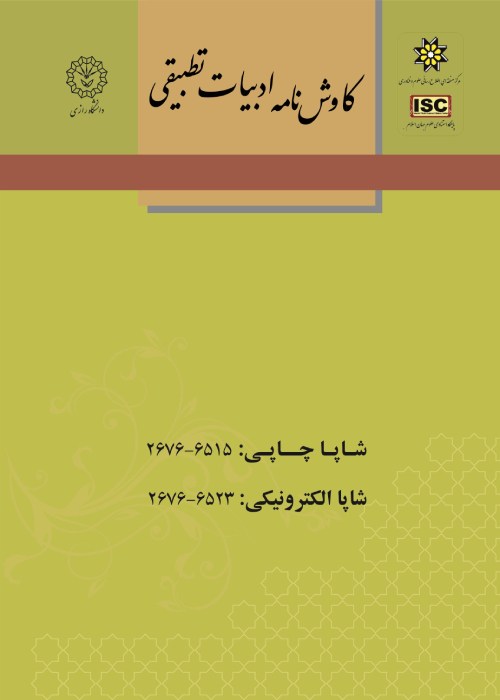Representation of World Literary Figures in National Literature (Case Study: Lamartine's Image in Ode Lamartine By Salah Labki)
Illustrating the countenances of renowned literary figures within the context of both native and national literatures is a prevalent literary trend that reflects the reciprocal connections between these literary traditions. In the realm of contemporary Arabic literature, the intersection with global literary expressions has paved the way for the emergence of distinguished poets and literary personalities. These individuals serve as conduits, translating the poetic endeavors of celebrated international poets into the domain of indigenous literature.The Romanticism movement is recognized as one of the foundational arenas for comparative literature on a global scale. Spanning the late 18th century and extending through the 19th century, it permeated all of Europe, capturing the interest of critics and writers alike. This era stimulated an inclination to assess various literatures and literary trends, fostering a spirit of comparison. Additionally, the Romantics displayed a fondness for exploration, venturing into distant lands and delving into historical depths. Consequently, this movement gave rise to a network of influence and reception within its scholarly domain.The trailblazers of the Romanticism movement in the Arab world, particularly in Lebanon, were exposed to French literature and the luminaries of French Romanticism during the period when French-language schools and educational institutions were active in Lebanon during the colonial era. Among these influential figures is Lamartine. Salah Labaki, captivated by Lamartine's persona, directly drew inspiration from him. In a poem titled "Lamartine," Labaki portrayed Lamartine's character and pivotal life events through a Romantic lens, thus expressing his own perspective on the subject. Given the evident influence of Salah Labaki from Lamartine, this research is conducted within the framework of the French school in comparative literature, where the research criterion involves not only resemblance but also the substantiation of the flow of influence and reception.The research necessity identified by the authors of this article pertains to the absence of a comprehensive and systematic examination of Salah Labaki's perspectives on Lamartine's character, as portrayed in the specified poem. The significance of this undertaking is heightened by Labaki's emergence at a pivotal juncture in contemporary Arabic literature, marking the inception of a literary school. The mentioned poem serves as a vivid representation of the influential impact of eminent European Romanticists like Lamartine in shaping the Arab Romanticism movement. The research approach adopted in this study is descriptive-analytical, and from a methodological standpoint, it aligns with the categorization of a comparative literature study, as elucidated in the theoretical foundations section of the research.The foundation for interpreting the studied work in this research centers on the acknowledgment that Salah Labaki has employed the events from Lamartine's life and character as a means to elucidate his own Romantic perspective. This serves the purpose of illustrating the fundamental resemblance between Labaki's worldview and that of Lamartine. Consequently, the current investigation applies the principles of the Romanticism school to analyze and delve into the examined text. Indeed, the aforementioned poem can be viewed as an outcome of Romanticism, a significant literary movement or school. It is crucial to note in this context that the influence exchange between the Romanticism school and Eastern lands operates in a bidirectional manner. For Lamartine, akin to other eminent Romanticists, these lands have perpetually served as wellsprings of inspiration, as the Orient appears to them as imaginative, mystical, and wondrous (Servat, 2003: 44), with diverse depictions of it present in European Romanticist texts.The poem "Lamartine" underscores the significant impact of one of the preeminent Romantic poets globally on contemporary Lebanese poetry, particularly in the works of Salah Labaki. Labaki, drawing inspiration from Lamartine's ideological perspectives, adopts a deeply reflective stance towards natural phenomena and human existence. His poetry deviates from the enumeration of moral virtues and traditional elegiac meanings.In this poem, Labaki's perspective on the enigmatic event of death closely mirrors Lamartine's ideological outlook. Within the Romanticist framework, death is perceived as a gateway to a transcendental and idealistic realm. Consequently, the conventional apprehension of death, a prevalent theme in traditional poetry, gives way in the poet's vision to optimism and a sense of surrender.In this poem, in alignment with the Romanticists' perspective, Salah Labaki attributes a sacred and divine significance to poets. He portrays Lamartine's character as a guide for the people, emphasizing the reformative role of Romantic ideology. Conversely, the realists, who oppose Romanticism, criticize Romanticists for being disconnected from reason and logic, accusing them of indulging in illusion and fantasy.Salah also imparts a spiritual and mythical dimension to the women who played roles in Lamartine's life, depicting them as his spiritual support on the journey of spiritual exploration and mystical ascent toward perfection. Through this approach, he somewhat rationalizes Lamartine's extramarital love affairs with his lover.According to Labaki, Lamartine's isolation and solitude stem from the Romantic belief that ordinary people fail to recognize the worth and dignity of geniuses. The Romanticists assert that only geniuses have the capacity to liberate individuals from blind imitation.Labaki's perspective on nature and natural occurrences in this poem aligns seamlessly with the views of other Romanticists, including Lamartine himself. The poet imbues the phenomena with the hues of his inner emotions and thoughts, establishing a connection with them. Within this worldview, natural phenomena deviate from their traditional representation in classical poetry, serving the purpose of conveying the poet's reflections and contemplations through the voice of the phenomena.
- حق عضویت دریافتی صرف حمایت از نشریات عضو و نگهداری، تکمیل و توسعه مگیران میشود.
- پرداخت حق اشتراک و دانلود مقالات اجازه بازنشر آن در سایر رسانههای چاپی و دیجیتال را به کاربر نمیدهد.


